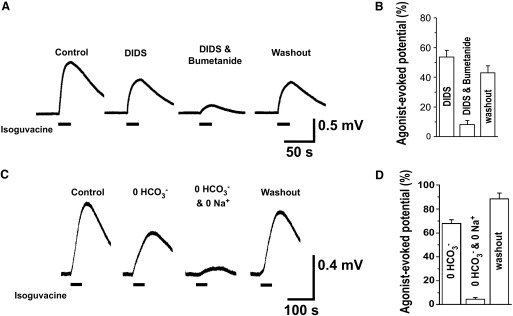FIG. 8.

NKCC1-independent chloride accumulation is sensitive to 4,4′-diisothiocyanatostilbene-2,2′-disulfonic acid (DIDS) and dependent on HCO3−. Isoguvacine was puffed (100 μM, 20-s duration, every 15 min) onto the motor column while the evoked potentials were recorded in the Fem nerve. A: the Cl−/HCO3− exchanger inhibitor, DIDS (50 μM), was added to the bath (60 min), which significantly reduced the evoked potential. This response was then nearly abolished on subsequent addition of 10 μM bumetanide (45 min). The response partially recovered after drug washout (45 min). B: averages are shown in the bar chart on the right (n = 5, P < 0.001). C: a “0 HCO3−” extracellular solution (45 min) also reduced the evoked potential, which is then nearly abolished with the perfusion of “0 Na and 0 HCO3−” extracellular solution (45 min). The response recovers after normal solution is restored. D: averages are shown in the bar chart on the right (n = 3, P < 0.001). Error bars represent SE.
